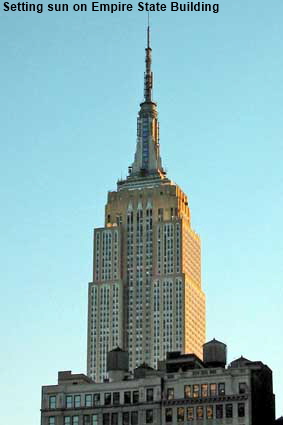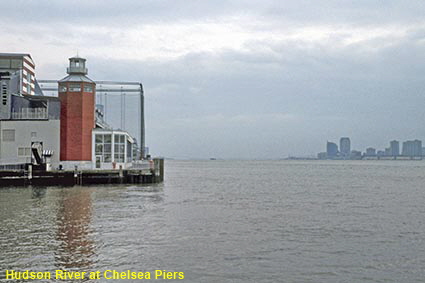Chelsea & Gramercy
The expansion of the City that started in the early 19th century with Greenwich Village continued northwards and by the 1830s this area was changing quickly from farmland to city suburb. It grew into a very diverse area, with commerce centred around Madison Square, elegant houses around Gramercy Square, the fashion industry based in the Garment District around 7th Avenue, the Meatpacking District to the south west, and on the shores of the Hudson River the piers that serviced huge liners. Compared to Midtown to the north and Greenwich Village to the south, this area seems a little short on tourist attractions, but there is one big one that brings most here - the Empire State Building.
Hudson River at Chelsea Piers
Most of the piers used by the great liners have been demolished or are derelict. Chelsea Piers were once used by famous Cunard and White Star lines, but by the 1980’s they were derelict and plans were made to demolish them to build a new highway. They were saved and have now been renovated and turned into a sports and entertainment complex. The ‘lighthouse’ on the left of the picture is part of a corporate events venue. Over the other side of the Hudson River on this grey day loom the tower blocks of New Jersey.
Theodore Roosevelt's birthplace, 20th Street
President Theodore Roosevelt was born in Number 28, 20th Street on October 27, 1858. He lived at this address until age 14 and on September 14, 1901 he became the first US President to have been born in New York. He was sickly as a child suffering from severe asthma which he brought under control through a strenuous exercise regime. You may notice that we have not said that he was born in this house. That is because in 1916 the house was demolished to make way for a shop. However, after Roosevelt’s death in 1919 his family purchased the site and rebuilt the house using the identical house at No 26 as a model. No 26 was once the home of Theodore's uncle Robert Barnwell and his wife but it had to be demolished to make way for a museum alongside the replica house. The replica was reconstructed to represent the way the house would have looked in 1865 and the Roosevelt family donated many items of original furniture. It opened to the public in 1923 run by the Women's Roosevelt Memorial Association. In 1962 it became the Theodore Roosevelt Birthplace National Historic Site run buy the National Parks Service. The house is open for guided tours Wednesday to Sunday and the tours are free. Click Tab 2 to see the Library with a view into the Dining Room.
Setting sun on Empire State Building from Avenue of the Americas
The story of how the Chrysler Building and the Empire State Building competed for the title of tallest building in the world is well known. Officially opened on May 1, 1931 the Empire State snatched the title that the Chrysler building had held for only months and it kept the title for 41 years. At a total height of 443 metres (1454 feet) the Empire State is an impressive sight and the view from the Obervatory at 320 metres (1050 feet) high is on a good day a must for any tourist. Our first trip up the Empire State Building was a disappointment as a bank of cloud blew in while we were making our way to the top. One tip is to go early as the queues (lines) to visit the Observatory can get very long once the majority of tourists are up and about. Click Tab 2 to see the lobby of the Empire State Building.
Chelsea Piers & Empire State Building from Boat Tour
If you are not familiar with New York you probably think that Manhattan is wall to wall skyscrapers. In reality most of the skyscrapers are clustered in Midtown and Lower Manhattan and the area in between is relatively low rise. By choosing not to build the then tallest building in the world in Midtown or Lower Manhattan the designers of the Empire State Building ensured that it stands out proudly on the horizon.
Meat Packing district at Hudson & 14th Streets
To the south west is a district that when we visited in 2001 was run down but showing signs of a new life. The Meat Packing District, otherwise known as Gansevoort Market, is home to a declining meat market and is undergoing the sort of transformation that has made Greenwich Village highly fashionable. Derelict buildings are undergoing expensive facelifts and hotels, boutiques, restaurants and clubs are springing up. When we visited in 2019 we did not find any meat packing companies although there were still buildings undergoing renovations.
DLU190521
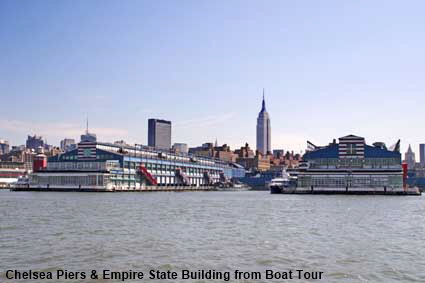
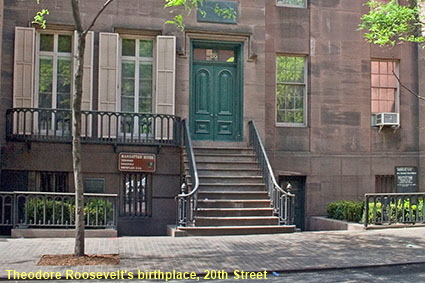
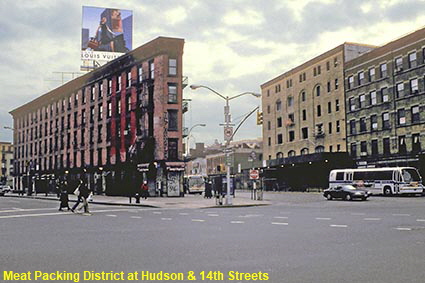
Click on Minimap to navigate


To move forwards or backwards through the Manhattan trail click the arrows above, or select your next destination on the Minimap.
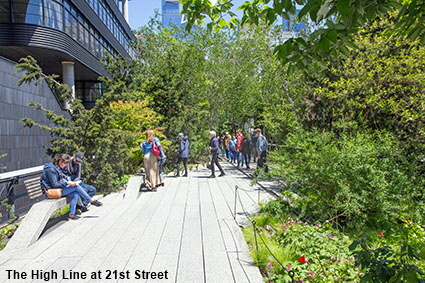
The High Line at 21st Street
From 1851 to 1929 10th Avenue was a very dangerous place, not because of traffic or gangsters, but because there was a railroad running along it. Trains, traffic and pedestrians don’t mix so in 1929 the New York Central Railroad agreed to rebuild the line as an elevated railroad to keep the trains clear of the roads. The High Line opened in 1934 running from 34th Street in the north to St. John’s Park Terminal at Spring Street. It eliminated 105 street level railroad crossings. After World War II traffic declined and the southern end of the line was demolished in the 1960s. The remainder continued in use until it was abandoned in 1980. Attempts both to demolish and reopen the High Line were thwarted, leaving it as a rusting monument to the railroad era. The idea of turning it into a public open space was first mooted in 1999 and early in the 21st Century plans were drawn up to convert it into a linear public park. Work on the southern part of the line began in April 2006 and the southern section of the High Line opened to the public as a park in June 2009. A second section opened 2 years later. Work to convert the northern section the northern section at Hudson yards began in September 2012. Unlike the southern section of the High Line, the northern section has preserved the plants that established themselves naturally in the line after it was abandoned Click Tab 2 to see the northern section of the High Line at Hudson Yards.
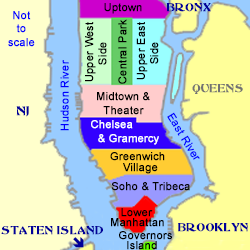

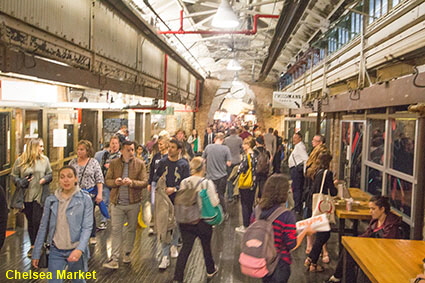
Chelsea Market
Meat was not the only product of the Meatpacking District. In the 19th century butchers lard was an ingredient used in making biscuits and there was plenty of it available in the Meatpacking District. A local biscuit company set up its factory in these premises in the 1890s. In 1898 the company merged with two others to form the National Biscuit Company which later became known as Nabisco. The biscuit factory relocated to the suburbs In 1958. Nabisco had used the High Line to transport goods to and from the factory, so their departure contributed to its demise. For decades after the old factory building was little used until in 1990 investor Irwin B Cohen bought it. Seven years later the building opened to the public as Chelsea Market, an indoor food hall with more than thirty-five vendors. Click Tab 2 to see the Sushi Bar at Lobster Place in Chelsea Market,
© Mike Elsden 1981 - 2025
The contents of this page may not be reproduced in full or in part without permission
